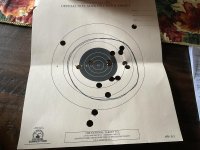Seriously, Larry, that's one nice 1950 target .45!
The old ones I've personally seen generally have cylinder throats .001-.002" over bore diameter. Perfect for cast bullet accuracy!
These guns were built specifically for 2700 Bullseye match shooting.
They pose some unique challenges for accuracy-minded handloaders, but there's a few tricks to get the most out of them. This, and the 1955 target .45 are the only target revolvers made by S&W that have a sharp headspacing shoulder in each chamber, rather than the more funnel-like shoulder as used with rimmed cartridges!
Here's some of my tricks:
-Besides measuring the cylinder throats, measure the chamber depths (from cylinder breech to the sharp shoulder for casemouth headspacing) and add that to the headspacing gap between the firing pin bushing and the breechface of the cylinder. That's your maximum case length. Your brass needs to be close to that by a few thousandths of an inch. The more consistent, the better.
-Often, 45 auto rim brass is a little too short. Check and sort! You definitely don't want an excessive gap between the casemouth and that sharp shoulder in the chamber. Your accuracy will suffer when the bullet gets shaved!
-If you use (half) moon clips, flatten them out and thin them by lapping them with sandpaper laying on a dead flat surface. Those clips are for ejecting the brass. If used for headspacing, accuracy will suffer, especially if they are not
perfectly flat.
If you do use ACP, and don't mind plucking out each empty one by one, so long as your case length matches the chamber/headspacing you'll get fine accuracy w/o the clips.
-Another approach with brass for best accuracy is to use trimmed-down 45 Colt brass. You trim it to within a couple thousandths less than the headspacing figure determined in the first step.
The loaded ammo with this brass headspaces off of the casemouth not the rim!!! In fact, you will notice an odd looking gap between the rim and the cylinder breech. That's OK! The rim is for ejection only.
If you're using cast bullets specifically sized to your cylinder throats, this method will get the driving band perfectly centered with the cylinder throats. With a SWC, you may need to give them a little press to fully seat them in the chamber. There is zero gap between the casemouth and the headspacing shoulder in the chamber.
With a good, quality target load you will be amazed at the accuracy!!
With sloppy handloading technique, be warned that my methods might give you problems. Oversized, crooked, or canted bullets won't shoot accurately and may cause the casehead to bind on the recoil shield. If your sizing die is undersized to where there is a bulge in your loaded ammo equal to where the bullet base is, you may experience problems. Also, lead shavings around the casemouth from sloppy bullet seating and/or crimping will definitely cause trouble.
I think this is what led to S&W opening up their cylinder throats and deepening the chamber cuts on the later 25-2. They probably got tired of inattentive handloaders complaining about malfunctions with their finely fitted target revolvers when the real problem was their ammo.
These are great guns that can shoot amazingly well.
Enjoy!!



